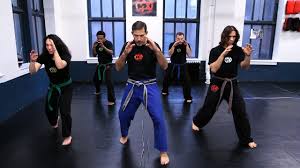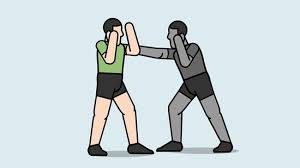Muay Thai, often referred to as the “Art of Eight Limbs,” is a striking martial art that emphasizes the use of fists, elbows, knees, and shins. While Muay Thai is renowned for its offensive techniques, mastering defensive skills is equally crucial for success in this dynamic sport. Effective defense not only protects you from your opponent’s attacks but also sets up opportunities for counterattacks and strategic positioning. In this comprehensive guide, we’ll explore essential defensive techniques in Muay Thai that every practitioner should master.
1. The Basic Stance: Foundation of Defense

The Muay Thai stance, or “Yee Na,” serves as the foundation for both offensive and defensive maneuvers. A solid stance ensures balance and readiness for any incoming attack. To establish an effective stance:
- Feet Position: Stand with your feet shoulder-width apart, with your lead foot slightly forward. Your rear foot should be positioned at a 45-degree angle.
- Knees and Hips: Keep your knees slightly bent and your hips square to your opponent. This alignment allows for quick adjustments and movements.
- Weight Distribution: Distribute your weight evenly between both legs, enabling you to move seamlessly and maintain balance.
2. The High Guard: Protecting Your Head and Face
The high guard is a fundamental defensive technique used to block strikes aimed at your head and face. To execute a proper high guard:
- Elbow Position: Raise your elbows to shoulder level, creating a protective shield around your head.
- Hands Up: Keep your hands close to your face, with your palms facing inward. Your gloves should cover your cheeks and chin.
- Chin Tucked: Tuck your chin down towards your chest to minimize the target area and reduce the impact of strikes.
3. The Low Guard: Defending Against Body Shots
The low guard is designed to protect your torso and midsection from body shots. To adopt the low guard position:
- Elbows In: Keep your elbows close to your body, forming a shield over your ribs and stomach.
- Hands Lowered: Position your hands lower, around chest height, to cover your torso and upper abdomen.
- Body Tilt: Slightly lean forward to present a smaller target and enhance your ability to absorb body shots.
4. The Parry: Redirecting Incoming Strikes
The parry is a defensive technique used to deflect or redirect an opponent’s strikes, reducing their impact. To perform an effective parry:
- Use the Forearm: Extend your forearm to meet the incoming strike, angling it to deflect the attack away from your body.
- Timing and Precision: Time your parry accurately to intercept the strike just before it lands. Aim to redirect the attack toward your opponent’s offside.
- Follow Through: After parrying, quickly return to your defensive stance to prepare for the next move.
5. The Block: Absorbing Strikes with the Arms and Legs

Blocking is a crucial technique to absorb and mitigate the force of strikes. Key blocks in Muay Thai include:
- Forearm Block: Use your forearm to absorb punches and elbows. Angle your arm slightly to deflect the impact.
- Shin Block: Raise your knee and shin to block kicks aimed at your body or legs. Angle your shin to reduce the impact on your thigh.
- Elbow Block: For incoming elbows, use the outer part of your elbow to block and deflect the strike.
6. The Slip: Evading Strikes with Head Movement
The slip involves moving your head to avoid an opponent’s attack while staying in a position to counter. To execute a slip:
- Head Movement: Shift your head to the side or back to avoid punches or kicks. Keep your eyes on your opponent to anticipate their movements.
- Body Movement: Coordinate your head movement with a slight shift in your body weight to maintain balance and readiness for a counterattack.
- Minimal Movement: Aim for minimal head movement to avoid telegraphing your intentions and maintain your defensive posture.
7. The Bob and Weave: Dodging Strikes with Body Movement
The bob and weave technique involves bending your body and moving your head to dodge incoming strikes. To perform a bob and weave:
- Bend Your Knees: Lower your body by bending your knees, which allows you to move under and around punches.
- Side-to-Side Movement: Shift your body weight from side to side while maintaining a low stance. This motion helps you evade punches and stay agile.
- Head Movement: Combine the body movement with head movement to avoid strikes and create openings for counterattacks.
8. The Clinch: Controlling the Opponent at Close Range
The clinch is a defensive and offensive technique used to control an opponent at close range. To effectively execute a clinch:
- Grab and Control: Secure your opponent’s neck or body with your arms, using your elbows to create a barrier and limit their movement.
- Body Position: Maintain a strong posture and keep your body close to your opponent’s. This position prevents them from landing strikes and creates opportunities for knee strikes and sweeps.
- Work for Position: Use the clinch to maneuver your opponent, aiming to gain a dominant position and set up your next move.
9. The Counterattack: Turning Defense into Offense
An effective defense often leads to a successful counterattack. To implement counterattacks:
- Read Your Opponent: Anticipate your opponent’s moves and look for openings during their attack.
- Quick Response: After defending or evading an attack, immediately launch a counterattack with punches, kicks, or knees.
- Practice Combinations: Develop combinations of defensive and offensive techniques to seamlessly transition from defense to attack.
10. The Footwork: Enhancing Defensive Mobility

Footwork is crucial for maintaining a strong defensive position and evading attacks. Key footwork techniques include:
- Pivoting: Rotate on your lead foot to change angles and evade strikes. Pivoting helps you avoid direct hits and create new angles for counterattacks.
- Sliding: Move laterally or backward by sliding your feet to maintain distance from your opponent and avoid their strikes.
- Stepping: Use quick, deliberate steps to reposition yourself and stay within range for defensive maneuvers and counterattacks.
Conclusion
Mastering defensive techniques in Muay Thai is essential for both protecting yourself and setting up effective counterattacks. By focusing on fundamental techniques such as the high guard, low guard, parrying, blocking, slipping, and clinching, you can enhance your defensive skills and become a more well-rounded fighter. Incorporate these techniques into your training regimen, practice them consistently, and apply them strategically in your matches. With dedication and skillful execution, you’ll be better equipped to handle any challenge and excel in the art of Muay Thai.



